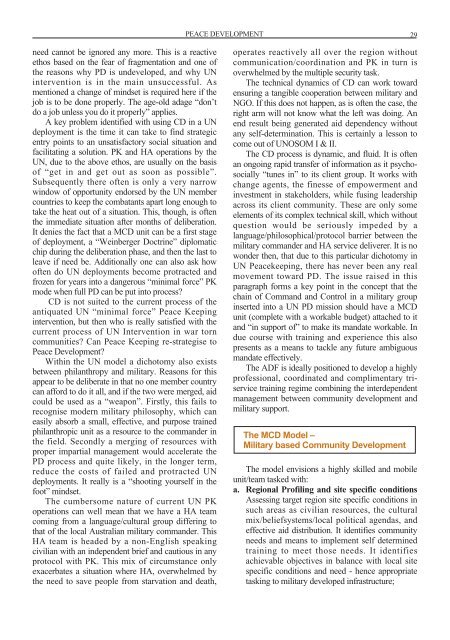ISSUE 136 : May/Jun - 1999 - Australian Defence Force Journal
ISSUE 136 : May/Jun - 1999 - Australian Defence Force Journal
ISSUE 136 : May/Jun - 1999 - Australian Defence Force Journal
- No tags were found...
You also want an ePaper? Increase the reach of your titles
YUMPU automatically turns print PDFs into web optimized ePapers that Google loves.
PEACE DEVELOPMENT 29need cannot be ignored any more. This is a reactiveethos based on the fear of fragmentation and one ofthe reasons why PD is undeveloped, and why UNintervention is in the main unsuccessful. Asmentioned a change of mindset is required here if thejob is to be done properly. The age-old adage “don’tdo a job unless you do it properly” applies.A key problem identified with using CD in a UNdeployment is the time it can take to find strategicentry points to an unsatisfactory social situation andfacilitating a solution. PK and HA operations by theUN, due to the above ethos, are usually on the basisof “get in and get out as soon as possible”.Subsequently there often is only a very narrowwindow of opportunity endorsed by the UN membercountries to keep the combatants apart long enough totake the heat out of a situation. This, though, is oftenthe immediate situation after months of deliberation.It denies the fact that a MCD unit can be a first stageof deployment, a “Weinberger Doctrine” diplomaticchip during the deliberation phase, and then the last toleave if need be. Additionally one can also ask howoften do UN deployments become protracted andfrozen for years into a dangerous “minimal force” PKmode when full PD can be put into process?CD is not suited to the current process of theantiquated UN “minimal force” Peace Keepingintervention, but then who is really satisfied with thecurrent process of UN Intervention in war torncommunities? Can Peace Keeping re-strategise toPeace Development?Within the UN model a dichotomy also existsbetween philanthropy and military. Reasons for thisappear to be deliberate in that no one member countrycan afford to do it all, and if the two were merged, aidcould be used as a “weapon”. Firstly, this fails torecognise modern military philosophy, which caneasily absorb a small, effective, and purpose trainedphilanthropic unit as a resource to the commander inthe field. Secondly a merging of resources withproper impartial management would accelerate thePD process and quite likely, in the longer term,reduce the costs of failed and protracted UNdeployments. It really is a “shooting yourself in thefoot” mindset.The cumbersome nature of current UN PKoperations can well mean that we have a HA teamcoming from a language/cultural group differing tothat of the local <strong>Australian</strong> military commander. ThisHA team is headed by a non-English speakingcivilian with an independent brief and cautious in anyprotocol with PK. This mix of circumstance onlyexacerbates a situation where HA, overwhelmed bythe need to save people from starvation and death,operates reactively all over the region withoutcommunication/coordination and PK in turn isoverwhelmed by the multiple security task.The technical dynamics of CD can work towardensuring a tangible cooperation between military andNGO. If this does not happen, as is often the case, theright arm will not know what the left was doing. Anend result being generated aid dependency withoutany self-determination. This is certainly a lesson tocome out of UNOSOM I & II.The CD process is dynamic, and fluid. It is oftenan ongoing rapid transfer of information as it psychosocially“tunes in” to its client group. It works withchange agents, the finesse of empowerment andinvestment in stakeholders, while fusing leadershipacross its client community. These are only someelements of its complex technical skill, which withoutquestion would be seriously impeded by alanguage/philosophical/protocol barrier between themilitary commander and HA service deliverer. It is nowonder then, that due to this particular dichotomy inUN Peacekeeping, there has never been any realmovement toward PD. The issue raised in thisparagraph forms a key point in the concept that thechain of Command and Control in a military groupinserted into a UN PD mission should have a MCDunit (complete with a workable budget) attached to itand “in support of” to make its mandate workable. Indue course with training and experience this alsopresents as a means to tackle any future ambiguousmandate effectively.The ADF is ideally positioned to develop a highlyprofessional, coordinated and complimentary triservicetraining regime combining the interdependentmanagement between community development andmilitary support.The MCD Model –Military based Community DevelopmentThe model envisions a highly skilled and mobileunit/team tasked with:a. Regional Profiling and site specific conditionsAssessing target region site specific conditions insuch areas as civilian resources, the culturalmix/beliefsystems/local political agendas, andeffective aid distribution. It identifies communityneeds and means to implement self determinedtraining to meet those needs. It identifiesachievable objectives in balance with local sitespecific conditions and need - hence appropriatetasking to military developed infrastructure;

















